
Battle Born builds batteries to perform better, last longer and provide the deliverable power needed for weekend adventures or full-time boondocking. Our batteries were designed as replacements for the most common lead acid sizes on the market
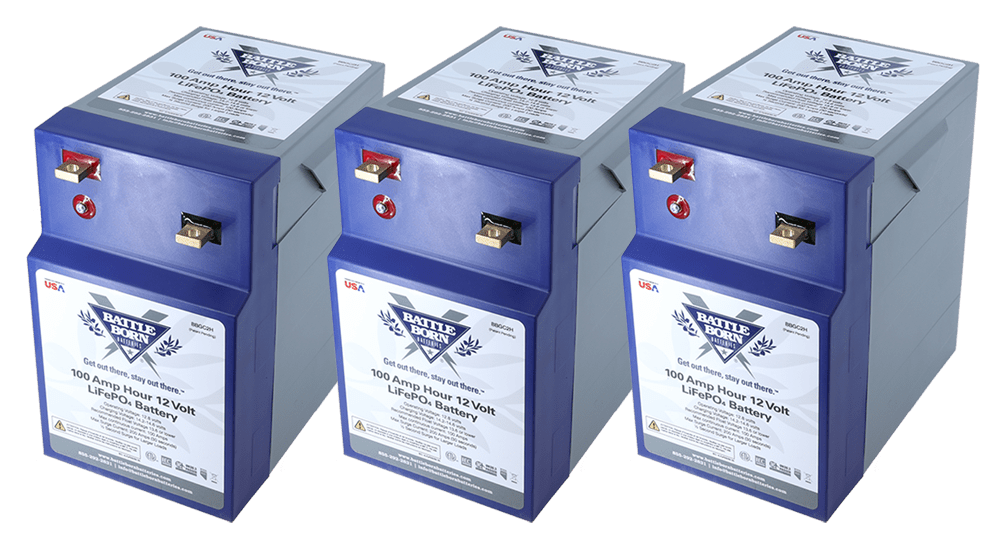
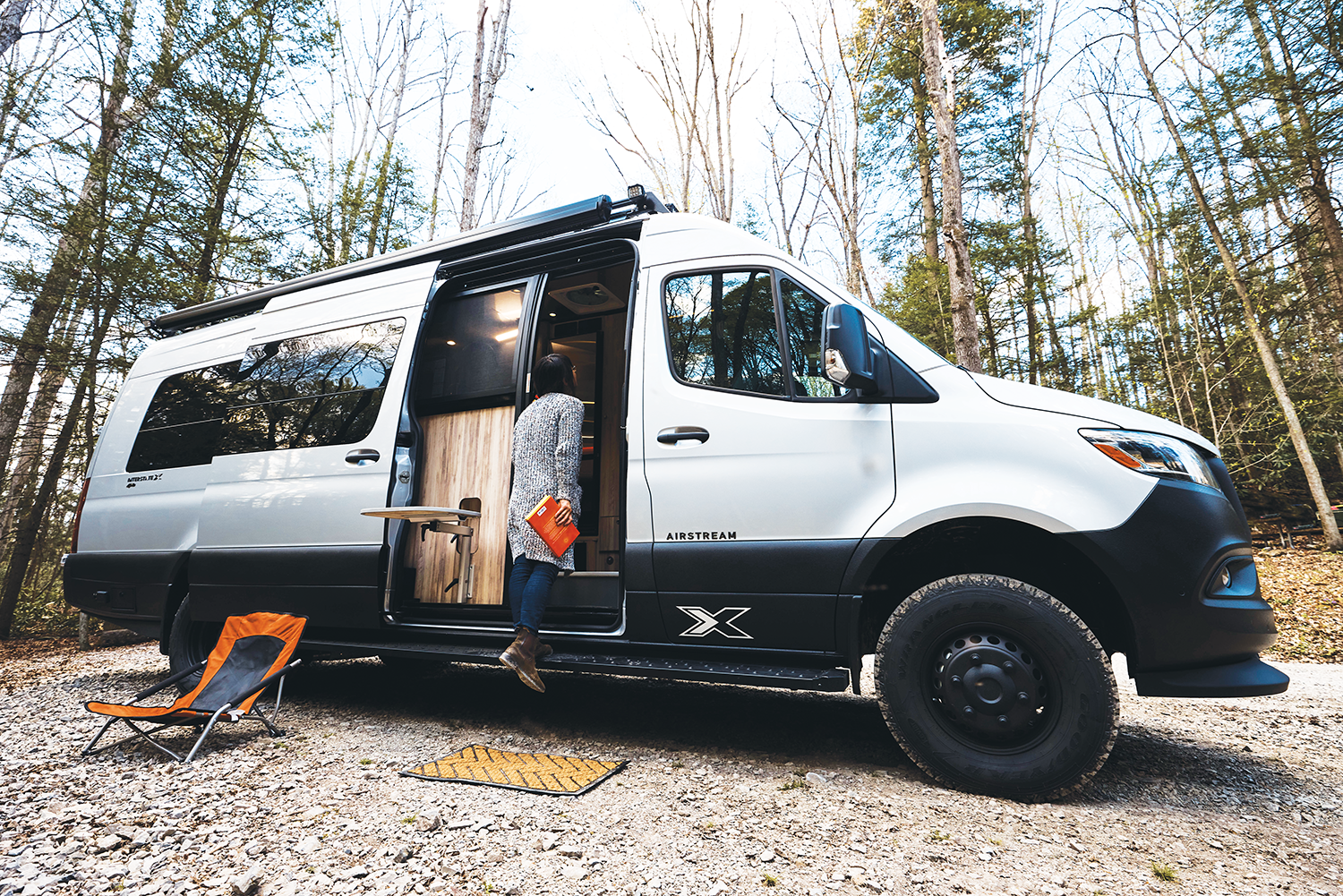
ABOUT BATTLE BORN BATTERIES
Battle Born Batteries specializes in providing top of the line lithium iron phosphate batteries. These revolutionary LiFePO4 batteries are recognized for their reliability and chemical stability.
Our team of trained battery specialists will answer any questions you have along the way. We will get you on the right path so you can get out there, stay out there!

Traditional Lead Batteries
Lead-acid batteries need to maintain at least a 50% charged level to deliver any power to your RV.
New Lithium Batteries
Lithium batteries can be depleted up to 100% without damaging the batteries or diminishing the available power.
100Ah 12V GC2 LiFePO4 Heated Battery
This 100Ah 12V GC2 deep cycle LiFePO4 battery uses a proprietary, low draw technology to keep your battery warm and ready to charge no matter what weather you may face. The stable chemistry and built-in battery management system help provide you with safe and reliable power on your adventures. Our batteries are also backed by a 10-year warranty to make your battery anxiety a thing of the past!
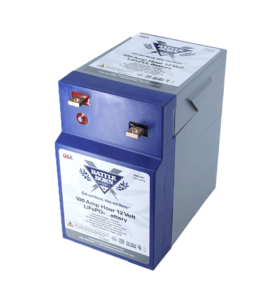
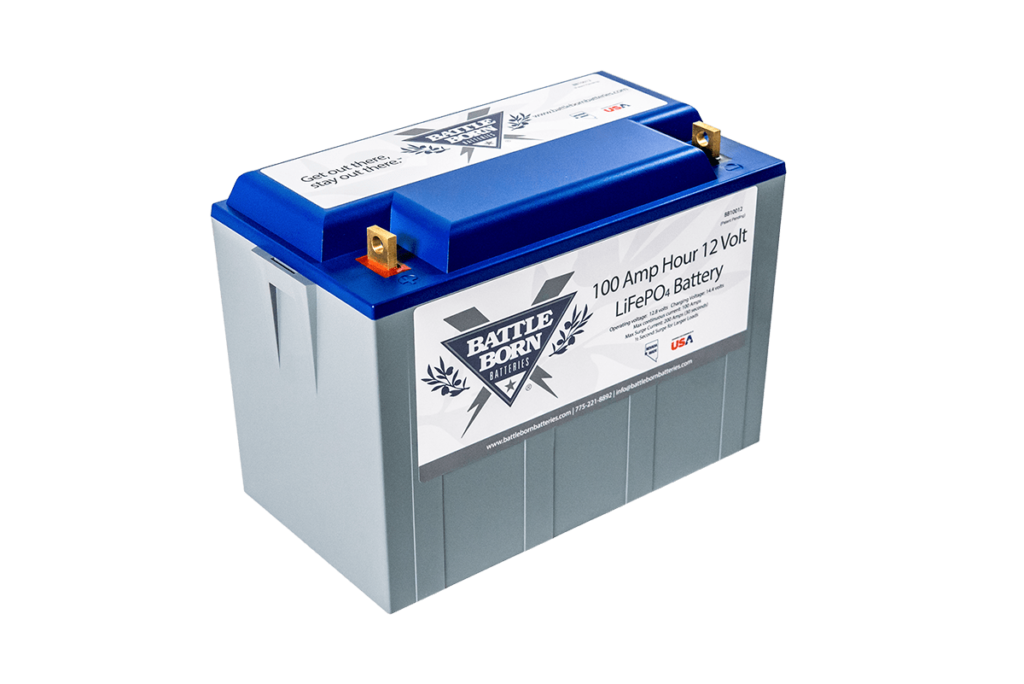
100 Ah 12V LiFePO4 Deep Cycle Battery
Our 100 Ah 12 V LiFePO4 Deep Cycle battery has a life expectancy of 3000-5000 cycles* with a 100 Amp Continuous current, 200 Amp Surge Current (30 seconds), and ½ second surge for higher loads. It’s time to upgrade your heavy lead-acid batteries to LiFePO4 batteries and upgrade your lifestyle and ability to adventure!
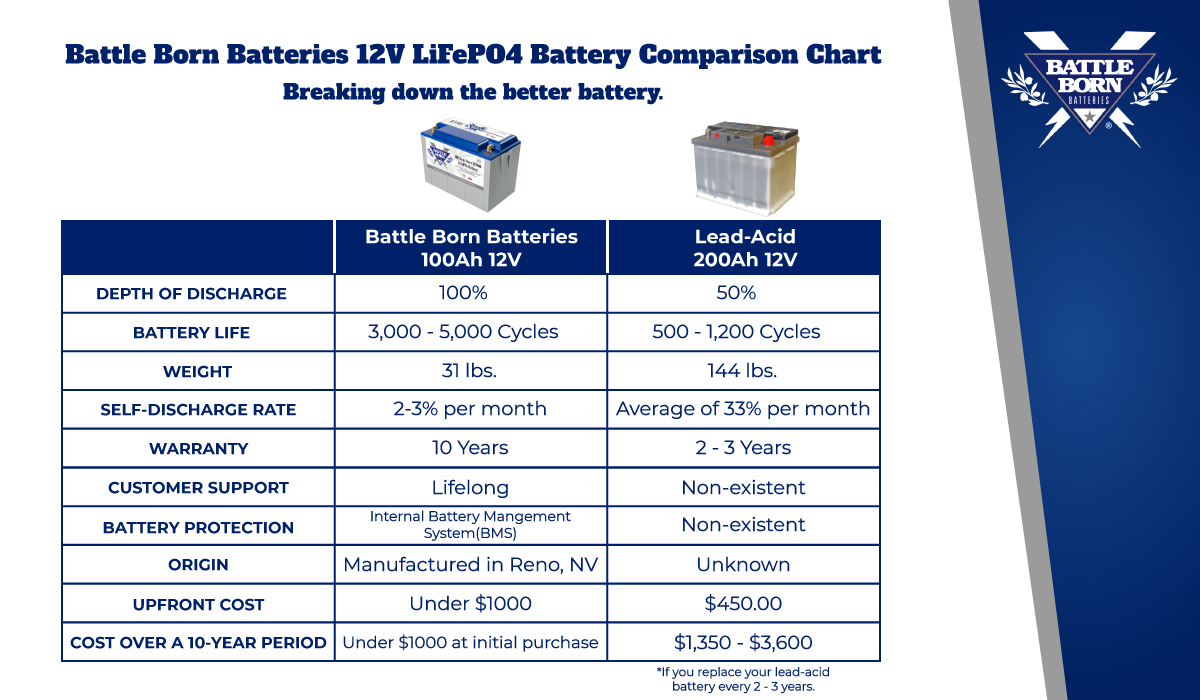
WHAT COMPONENTS DO I NEED?
Inverter Charger
A standard inverter is an electrical device that turns direct current (DC) power into alternating current (AC). A battery charger (converter) takes standard 120 V AC power and converts it to DC power to charge your batteries.
An inverter charger, much like the name states, is a combination of an inverter and a battery charger. It can take the AC power from a generator or shore power and charge your DC battery bank. It will also turn your battery’s DC power into AC power for any household appliances or electronics.
The Battle Born Shop carries multiple inverter/chargers for various power requirements from brands such as Victron and Magnum.
*One should note that additional components may need to be purchased alongside an inverter charger to best fit the needs of a system
Battery Isolation Manager
Battery Isolation Manager (BIM) is essential for alternator charging in 12 V systems only.
Battle Born recommends using the BIM in systems with 3 or more batteries. The BIM is designed to allow up to 225 amps of current to the batteries during a charge cycle. For smaller battery banks, this could lead to overcharging, which could potentially shorten the cycle life of the batteries.
The BIM will connect for 15 minutes every 35 minutes. That means that the BIM will connect for 15 minutes, disconnect for 20 minutes, and repeat this cycle until the coach battery is charged.
If the coach battery resting voltage exceeds 13.4 V, then the BIM will disconnect. A resting voltage greater than 13.4 V indicates a fully charged battery. Note that “resting voltage” means that no current is flowing to the coach battery. The BIM will disconnect if the alternator voltage exceeds 14.4 V. This protects the coach battery from over charging.
The BIM will disconnect if the voltage difference between the alternator and the coach battery is less than 0.1 V. If the voltage difference is too low, then there is a negligible charging current, and no need to connect to the coach battery. The BIM will disconnect if the alternator voltage drops below 13.3 V. If the alternator voltage is too low, than it cannot adequately charge the coach battery, so there is no reason to connect.
The Li-BIM 225 can monitor the voltages of your chassis and coach or auxiliary batteries. We recommend incorporating a BIM into your system when you want to charge your auxiliary batteries from your alternator. The BIM can monitor and regulate the voltages of your batteries in a variety of ways.
Converter Charger
A converter is a device that will convert the voltage from alternating current (AC) to direct current (DC). This varies from an inverter, which converts the voltage from DC to AC.
As you may know, most of the on-board electrical components in your RV run off DC power, while most household appliances will run off AC power. A converter charger will allow you to charge your battery bank from an AC power source, such as shore power or a generator. It will also allow you to take this DC power and distribute it to your on-board electrical components.
Battery Guardian
The battery guardian (BG) is a great component if you are looking for a low voltage disconnect.
Restricted for only 12 V power systems, this component allows you to remotely disconnect the vehicle from the battery by sensing the voltages of the coach or auxiliary batteries. We recommend using a BG when you intend to store your system for long periods of time.
When a BG is incorporated into your system, it works as a direct current (DC) disconnect switch, and it will cut off loads once your batteries reach 11.5 V. This will protect your batteries during long-term storage as it prevents the loads from draining your batteries and will completely eliminate the cumbersome task of physically removing the battery cable from the bank of batteries.
Solar Panels
Implementing a solar system can be confusing to say the least, panels come in a wide array of shapes, sizes, wattage, voltages and types. Should you go with Monocrystalline (MPPT), Polycristalline (PWM), thin film, or amorphous? Do you need 12 V panels, 24, 48, or maybe even 72 volts?
The good news is, by following a few basic rules, you can figure out how many watts you need for properly charging your Battle Born Batteries.
How many watts?
As a basic rule, match 200-250 watts of any solar type, for each 100 Ah of your lithium battery bank. This should allow charging from nearly empty to full in one full day of direct sunlight. Just make sure that your solar charge controller is compatible for charging lithium.
What voltage of panel?
Select your solar charge controller, then choose the voltage of your solar panels. MPPT solar charge controllers handle voltages of 75 V up to 250 V, depending on the model, meaning you can easily build a solar array with almost all voltage types. The less efficient PWM solar controllers usually only handle 12 or 24 volts, limiting your choices of solar panels.
Connect my solar array in series or parallel?
Again, this will depend on your solar charge controller. For most PWM controllers, parallel connections work best. Parallel connections keep voltage of your solar array low as these controllers can’t handle the higher volts. Series connecting is preferred with MPPT controllers as this can create more efficiency with the higher voltage that’s created connecting this way.
Parallel solar connections give a measure of shade tolerance, meaning if you cover one panel out of the array, the other panels still generate a good amount of power. Series solar connections give a bit more efficiency and power but tend to give much less power when one panel is shaded from the array. Many choose a hybrid of both series and parallel and will give the best of both worlds.
Solar Charge Controller
A solar charge controller is a current or voltage controller that manages the power that transfers from your solar array to your battery bank. A solar charge controller takes the power that comes from the solar array to charge your battery bank and acts as a one-way gate to prevent this power from transferring back to the solar array, which would subsequently drain the batteries.
There are two main types of solar charge controllers: Pulse Width Modulation (PWM) and Maximum Power Point Tracking (MPPT).
Pulse Width Modulation (PWM)
Pulse width modulation solar charge controllers are relatively simple controllers that are connected directly between your solar array and your battery bank. It will “pull down” the voltage of your solar array to match that of your battery bank.
As your battery bank approaches is maximum capacity, the PWM solar charge controller will begin to reduce the amount of power feeding into your batteries. A PWM solar charge controller will also trickle charge your batteries to keep them topped off once the battery bank is full.
An important thing to consider with these solar charge controllers is that the voltage of your solar array and your battery bank need to match so this makes it more ideal for smaller systems.
Maximum Power Point Tracking (MPPT)
Maximum Power Point Tracking solar charge controllers are a more complex option that also harvests more energy from the solar array, which leads to higher efficiencies. An MPPT solar charge controller will also act like a PWM in the sense that it will reduce the power flowing to your battery bank as it reaches maximum capacity.
Unlike a PWM, an MPPT controller can be used with a solar array and battery bank of different voltages. It will down convert the voltage of your solar array to match the battery voltage and will subsequently increase the current so more available solar power can be harvested. MPPT solar charge controllers are also 20-30% more efficient than PWM solar charge controllers, making them a great option for high power systems.
We offer a variety of sizes for solar charge controllers depending on the size of your solar array. We also offer Victron Solar Charge Controllers that can be pre-programmed for your specific system.
Battery Monitor
Battery monitors are great tools to help you keep track of your battery system. They can give you specific information, such as how much power you have left and total ampere-hours consumed. We carry three different types of battery monitors: the Victron BMV-712, the Victron BMV-702, and the Victron BMV-700.
The Victron BMV-700 and Victron BMV-702
The Victron BMV-700 and BMV-702 will calculate the remaining battery capacity based on your ampere-hours consumed, discharge current, and the age of your battery. The physical display can show voltage, current, ampere-hours consumed, the state of charge, time to go, and your power consumption in watts.
To install one of these monitors you just need to connect to the quick connect protection circuit board (PCB) on the current shunt. Some of the other features are that they offer include programmable audible and visible alarms, a programmable relay, and data storage which allows you to track battery usage and health.
The BMV-702 varies from the BMV-700 because it allows for an additional input to be able to measure the voltage of another battery, temperature, and midpoint voltage monitoring. Midpoint voltage monitoring gives you the voltage halfway along your string of batteries. This information can inform you if there is an issue with your battery system, which can prevent severe damage down the line. The BMV-702 also allows for alarm and relay settings for these additional features.
The Victron BMV-700 and-702 can become Bluetooth enabled by adding the Bluetooth Smart dongle to your system, This dongle simplifies the programming of your BMV and allows you to monitor your system on a smartphone, tablet, laptops, and other devices.
The Victron BMV-712
The Victron BMV-712 provides the same functionality as the BMV-702, but it also comes fully Bluetooth enabled. This will simplify the wireless communication between products and your overall installation process. To install it you make all electrical connected to your quick connect PCB on the current shunt, like you would do with the BMV-700 and BMV-702.
DC to DC Charger
DC to DC or battery to battery chargers are a great way to charge your Battle Born Batteries using your vehicle’s alternator and starting battery. These devices provide a quick and smart charge with the added benefit of isolating the chassis and coach batteries when not in use.
These devices are typically used in conjunction with one to two Battle Born Batteries as they reduce the charging current under the recommended charge rate.
Solar Upgrade Recommendations
90 Watt Long
Roof Mount Panels
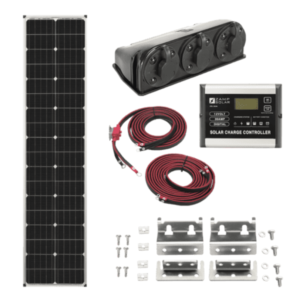
Perfect for Airstreams, our 90-Watt “L” Series Kit is specially designed for narrow or curved roofs. This kit’s unique mounting feet were created to accommodate curved roofs, while long, narrow panels make the most of available space. Expand this kit up to 510 watts.
90-Watt Long Expansion Kit Includes:
- 30-Amp, 5-stage PWM charge controller
- Pre-assembled wiring harness
- 3-port roof cap (ready for future expansions!)
- Stainless steel mounting hardware and specialized feet for curved roofs
OBSIDIAN® SERIES
100-Watt Solar Panel Kit
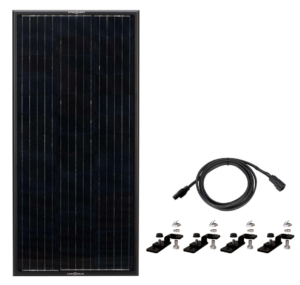
Perfect for small to mid-sized projects or rigs, our OBSIDIAN® SERIES 100-Watt panel works with any type of 12-Volt battery. As thin as a flexible panel and 30% lighter than a traditional panel without compromising efficiency, this American-made panel also features an ultra-aerodynamic profile and a sleek black anodized aluminum frame.
Kit Includes (ZSK1006):
-
One 100-watt solar panel
-
One 10-foot wire harness
-
One set of OBSIDIAN® SERIES universal mounting feet.
Panel Size: 43.6” tall x 20.7” wide x .67” thin
Panel Weight: 10.78 lbs
